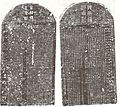Stele facts for kids
A stele (pronounced "stee-lee") is a tall, flat stone or wooden slab. People put them up to remember important things or people. Often, they have names and titles carved, etched, or painted on them.
Contents
What Are Stelae Used For?
Stelae have been used for many different reasons throughout history.
Marking Borders and Victories
Ancient people used stelae to mark the edges of their lands, like the boundary stelae of Akhenaten in Amarna. They also set them up to celebrate winning battles.
Where Were Stelae Found?
Stelae were very common in many ancient civilizations:
- Mesopotamia
- Greece
- Egypt
- Ethiopia
- China and some Buddhist cultures
- Mesoamerican civilizations, like the Olmec and Maya
The huge number of stelae found from ancient Egypt and Central America give us a lot of information about these old cultures. They are like stone history books!
Stelae Before Writing
Some very old standing stones, found from North Africa to Scotland, were put up by people who didn't have writing yet. These were part of Megalithic cultures during the Late Stone Age. They were monuments without words.
Different Types of Stelae
Many types of monuments you might know are actually kinds of stelae:
- An obelisk is a special, tall, four-sided stele.
- The Celtic high crosses in Ireland, Scotland, and Wales are also special stelae.
- Totem poles from North and South America are a type of stele.
- Even gravestones in cemeteries are a kind of stele.
Modern Stelae
In 2004, an architect named Peter Eisenman created a memorial in Berlin. It's called the Memorial to the Murdered Jews of Europe. It has about 2,700 blank stelae to remember the Holocaust.
Famous Stelae You Should Know
Some stelae are very famous because of the important information they hold:
- Code of Hammurabi: This stele has one of the oldest sets of laws ever found.
- Rosetta Stone: This stone helped experts finally understand ancient Egyptian hieroglyphs.
Related Topics
- Rune stones: These are stones with special ancient writing from Northern Europe.
Images for kids
-
Stele for the French 8th Infantry Regiment at the Waterloo battlefield.
-
Egyptian hieroglyphs on an Egyptian funerary stele in Manchester Museum.
-
A bixi-born stele from the Yuan Dynasty (AD 1349) in Qufu, China.
-
Ogham stone in Ratass Church, Ireland.
-
A victory stele of Naram-Sin, a Mesopotamian king from the 23rd century BC.
-
Stele #25 (around 2500 BC) from the Petit Chasseur in Sion, Switzerland.
-
A neolithic Sardinian menhir (around 2500 BC) found at Laconi.
-
The top part of the Code of Hammurabi (around 1750 BC), showing the king receiving his law from the sun god Shamash.
-
The Merneptah Stele (around 1200 BC), with the earliest mention of the name Israel.
-
A stele honoring the Thracian goddess Bendis (around 400 BC), carved at Athens.
-
A herm of Demosthenes, a 1520 recreation of the 280 BC original.
-
The Rosetta Stone (196 BC), which helped understand Egyptian hieroglyphs.
-
A Buddhist Stele from China, Northern Wei period, built after 583.
-
A rubbing of the Yamanoue Stele (681) in Takasaki, Japan.
-
Stele 35 from Yaxchilan (8th century), showing Lady Eveningstar.
-
The Nestorian Stele (781) records the success of the missionary Alopen in Tang China.
-
Rodney's Stone, a slab cross from Early Medieval Scotland.
-
Sueno's Stone (around 9th century) in Forres, Scotland.
-
Tombstones (funerary stelae) at the Common Burying Ground and Island Cemetery, Newport, Rhode Island.
-
A disc-shaped gravestone or hilarri in Bidarray, Basque Country.
See also
 In Spanish: Estela (monumento) para niños
In Spanish: Estela (monumento) para niños






























